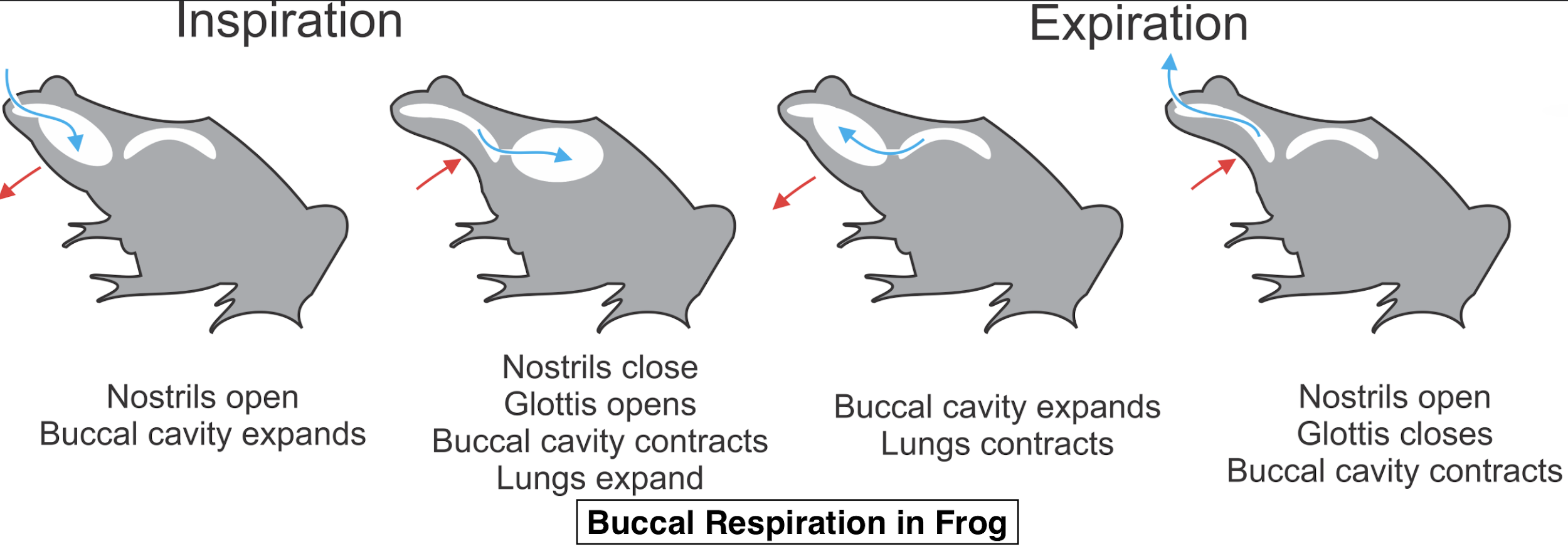
Answer
444.3k+ views
Hint: Buccal respiration is also known as the mouth respiration, which is a technique used by frogs to respirate during less metabolic conditions or areas where they conserve energy. The usual respiratory system will be inactive in this method.
Complete step by step answer:
The organs which do not participate in buccal respiration or buccopharyngeal respiration of
frogs are lungs. The base of the buccal system of frogs is raised and lowered in an alternate order so that there is not unnecessary expiration of air through the buccal cavity. The glottis will remain closed when buccal respiration occurs so that air cannot enter the lungs either leave it. . Blood capillaries are found high in the mucous layer of the buccal cavity.

So, the correct answer is ‘lungs’.
Additional information:
- The buccal mucus layer which is rich in blood capillaries will absorb oxygen by the process of diffusion or by the simple contraction or enlargement of sternohyoid and other related muscles such as petrolheads muscles.
- Oxygen which got dissolved in the wet mucus of the cavity will diffuse into the capillaries, then to blood, and Carbon dioxide will get diffused out into the cavity and goes out by the nares while expiration.
- Sex determination in frogs is influenced by environmental factors. The temperature around the egg determines the sex of the progeny.
Note:
- Pulmonary respiration is also called the lung respiration which frogs use while they live on land.
- While on land or the surface of water frogs are more physically active for the need for movement, swimming, hunting, and jumping and this demands more quantity of oxygen.
- Respiration through the lungs involves the usage of external and internal nares, olfactory cavity, buccopharyngeal cavity, glottis, and bronchioles.
Complete step by step answer:
The organs which do not participate in buccal respiration or buccopharyngeal respiration of
frogs are lungs. The base of the buccal system of frogs is raised and lowered in an alternate order so that there is not unnecessary expiration of air through the buccal cavity. The glottis will remain closed when buccal respiration occurs so that air cannot enter the lungs either leave it. . Blood capillaries are found high in the mucous layer of the buccal cavity.

So, the correct answer is ‘lungs’.
Additional information:
- The buccal mucus layer which is rich in blood capillaries will absorb oxygen by the process of diffusion or by the simple contraction or enlargement of sternohyoid and other related muscles such as petrolheads muscles.
- Oxygen which got dissolved in the wet mucus of the cavity will diffuse into the capillaries, then to blood, and Carbon dioxide will get diffused out into the cavity and goes out by the nares while expiration.
- Sex determination in frogs is influenced by environmental factors. The temperature around the egg determines the sex of the progeny.
Note:
- Pulmonary respiration is also called the lung respiration which frogs use while they live on land.
- While on land or the surface of water frogs are more physically active for the need for movement, swimming, hunting, and jumping and this demands more quantity of oxygen.
- Respiration through the lungs involves the usage of external and internal nares, olfactory cavity, buccopharyngeal cavity, glottis, and bronchioles.
Recently Updated Pages
Who among the following was the religious guru of class 7 social science CBSE

what is the correct chronological order of the following class 10 social science CBSE

Which of the following was not the actual cause for class 10 social science CBSE

Which of the following statements is not correct A class 10 social science CBSE

Which of the following leaders was not present in the class 10 social science CBSE

Garampani Sanctuary is located at A Diphu Assam B Gangtok class 10 social science CBSE

Trending doubts
A rainbow has circular shape because A The earth is class 11 physics CBSE

Which are the Top 10 Largest Countries of the World?

How do you graph the function fx 4x class 9 maths CBSE

Fill the blanks with the suitable prepositions 1 The class 9 english CBSE

The Equation xxx + 2 is Satisfied when x is Equal to Class 10 Maths

Find the value of the expression given below sin 30circ class 11 maths CBSE

What is the length of the alimentary canal in human class 11 biology CBSE

Give 10 examples for herbs , shrubs , climbers , creepers

What is BLO What is the full form of BLO class 8 social science CBSE




